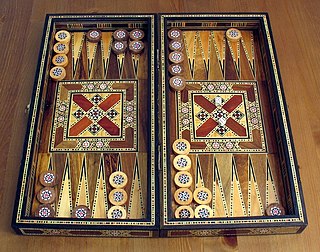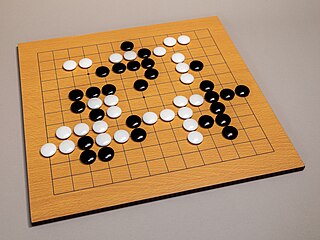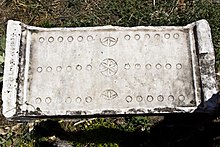
Board games are tabletop games that typically use pieces. These pieces are moved or placed on a pre-marked game board and often include elements of table, card, role-playing, and miniatures games as well.

Backgammon is a two-player board game played with counters and dice on tables boards. It is the most widespread Western member of the large family of tables games, whose ancestors date back at least 1,600 years. The earliest record of backgammon itself dates to 17th-century England, being descended from the 16th-century game of Irish.

Nine men's morris is a strategy board game for two players dating at least to the Roman Empire. The game is also known as nine-man morris, mill, mills, the mill game, merels, merrills, merelles, marelles, morelles, and ninepenny marl in English. In North America, the game has also been called cowboy checkers, and its board is sometimes printed on the back of checkerboards. Nine men's morris is a solved game, that is, a game whose optimal strategy has been calculated. It has been shown that with perfect play from both players, the game results in a draw.

Tables games are a class of board game that includes backgammon and which are played on a tables board, typically with two rows of 12 vertical markings called points. Players roll dice to determine the movement of pieces. Tables games are among the oldest known board games, and many different varieties are played throughout the world. They are called 'tables' games because the boards consist of four quadrants or 'tables'. The vast majority are race games, the tables board representing a linear race track with start and finish points, the aim being to be first to the finish line, but the characteristic features that distinguish tables games from other race games are that they are two-player games using a large number of pieces, usually fifteen per player.

Senet or senat is a board game from ancient Egypt that consists of ten or more pawns on a 30-square playing board. The earliest representation of senet is dated to c. 2620 BCE from the Mastaba of Hesy-Re, while similar boards and hieroglyphic signs are found even earlier, including in the Levant in the Early Bronze Age II period. Even though the game has a 2,000-year history in Egypt, there appears to be very little variation in terms of key components. This can be determined by studying the various senet boards that have been found by archaeologists, as well as depictions of senet being played throughout Egyptian history on places like tomb walls and papyrus scrolls. However, the game fell out of use following the Roman period, and its original rules are the subject of conjecture.

Tabula, meaning a plank or board, was a Greco-Roman board game for two players that has given its name to the tables family of games of which backgammon is a member.

An abstract strategy game is a type of strategy game that has minimal or no narrative theme, an outcome determined only by player choice, and in which each player has perfect information about the game. For example, Go is a pure abstract strategy game since it fulfills all three criteria; chess and related games are nearly so but feature a recognizable theme of ancient warfare; and Stratego is borderline since it is deterministic, loosely based on 19th-century Napoleonic warfare, and features concealed information.

The Royal Game of Ur is a two-player strategy race board game of the tables family that was first played in ancient Mesopotamia during the early third millennium BC. The game was popular across the Middle East among people of all social strata, and boards for playing it have been found at locations as far away from Mesopotamia as Crete and Sri Lanka. One board, held by the British Museum, is dated to c. 2600 – c. 2400 BC, making it one of the oldest game boards in the world.
Maharajah and the Sepoys, originally called Shatranj Diwana Shah and also known as the Mad King's Game, Maharajah chess, or Sarvatobhadra "auspicious on all sides", is a popular chess variant with different armies for White and Black. It was first played in the 19th century in India. It is a solved game with a forced win for Black.

Ludus latrunculorum, latrunculi, or simply latrones was a two-player strategy board game played throughout the Roman Empire. It is said to resemble chess or draughts, as it is generally accepted to be a game of military tactics. Because of the scarcity of sources, reconstruction of the game's rules and basic structure is difficult, and therefore there are multiple interpretations of the available evidence.

Tavli, sometimes called Greek backgammon in English, is the most popular way of playing tables games in Greece and Cyprus and is their national board game. Tavli is a compendium game for two players which comprises three different variants played in succession: Portes, Plakoto and Fevga. These are played in a cycle until one player reaches the target score - usually five or seven points.

Ludus in ancient Rome could refer to a primary school, a board game, or a gladiator training school. The various meanings of the Latin word are all within the semantic field of "play, game, sport, training".
Race game is a large category of board games, in which the object is to be the first to move all one's pieces to the end of a track. This is both the earliest type of board game known, with implements and representations dating back to at least the 3rd millennium BC in Egypt, Iraq, and Iran; and also the most widely dispersed: "all cultures that have games at all have race games". Race games often use dice to decide game options and how far to move pieces.

The “Druid of Colchester” is the name of an archaeological site discovered in Stanway, near Colchester. It is the grave of a person buried with surgical tools and a small board-game. The person whose cremated remains were buried in the grave could have been either a man or a woman, and is also called the Druid of Colchester.

–

The biga is the two-horse chariot as used in ancient Rome for sport, transportation, and ceremonies. Other animals may replace horses in art and occasionally for actual ceremonies. The term biga is also used by modern scholars for the similar chariots of other Indo-European cultures, particularly the two-horse chariot of the ancient Greeks and Celts. The driver of a biga is a bigarius.

Hounds and jackals or dogs and jackals is the modern name given to an ancient Egyptian tables game that is known from several examples of gaming boards and gaming pieces found in excavations. The modern name was invented by Howard Carter, who found one complete gaming set in a Theban tomb from the reign of ancient Egyptian pharaoh Amenemhat IV that dates to the 12th Dynasty. The latter game set is one of the best preserved examples and is today in the Metropolitan Museum of Art in New York. He called it "Hounds contra Jackals". Another, less often used modern name is "fifty-eight holes".

The ancient Romans had a variety of toys and games. Children used toys such as tops, marbles, wooden swords, kites, whips, seesaws, dolls, chariots, and swings. Gambling and betting were popular games in ancient Rome. Legislation heavily regulated gambling; however, these laws were likely not enforced. Tali, Terni lapilli, Duodecim Scripta, and Ludus latrunculorum were all popular games in ancient Rome. They were similar to poker, tic-tac-toe, backgammon, and chess respectively. Nine men's morris may also have been a popular game in ancient Rome. Roman children also played games simulating historical battles and could pretend to be important government officials.

A game board is the surface on which one plays a board game.
Polis was an ancient Greek board game. One of the earliest known strategy games, polis was a wargame resembling checkers. Its name appears in the Ancient Greek literature from around 450 BC to the 2nd century BC, and it seems to have been widely known in the region, particularly in Athens. The original rules of the game have been only partially preserved.


















